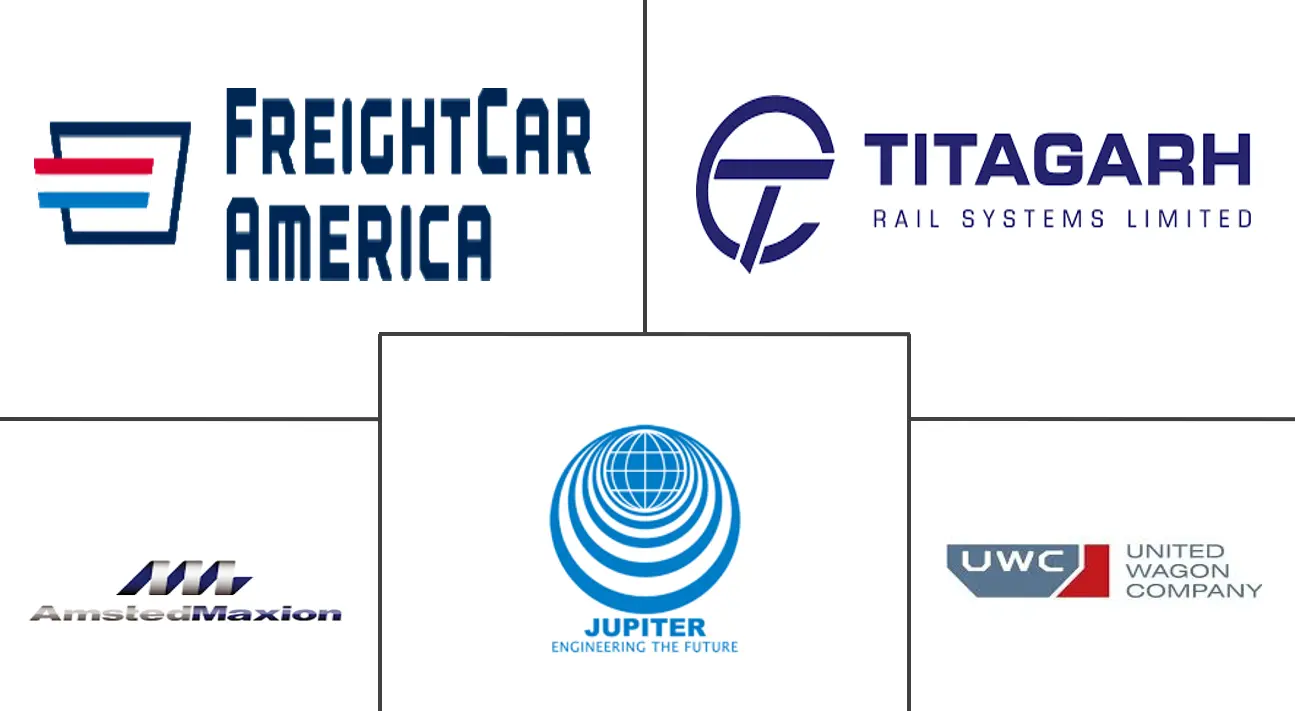Freight Wagons Market Size and Share
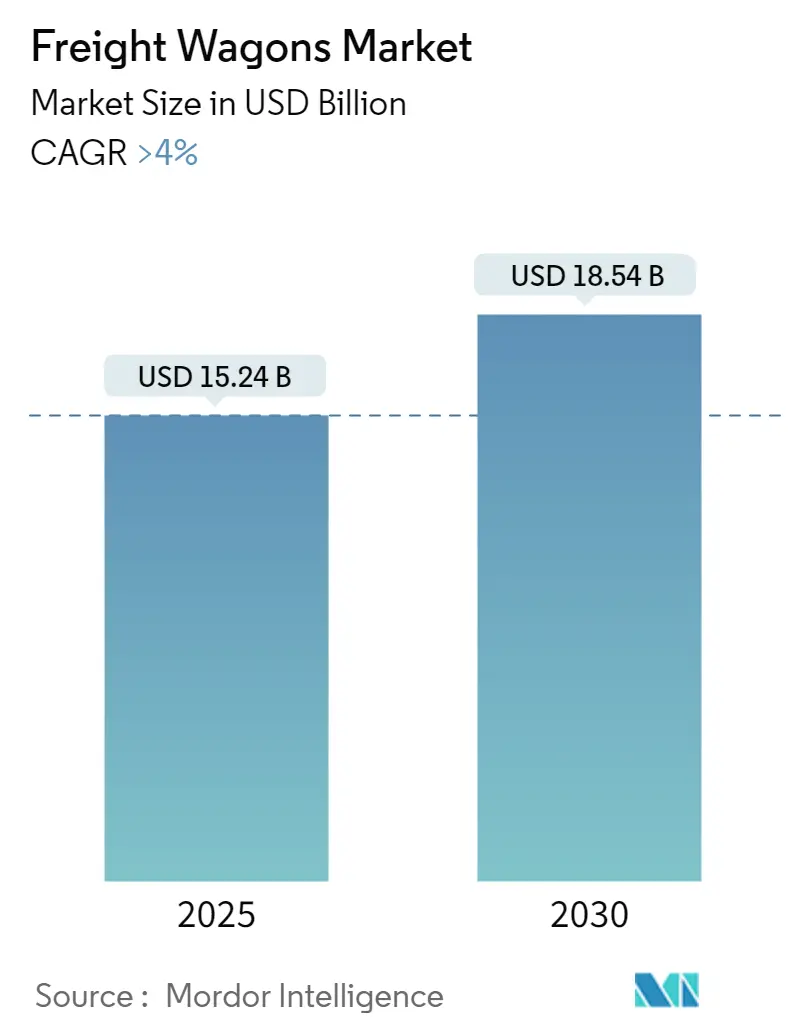
Freight Wagons Market Analysis by Mordor Intelligence
The Freight Wagons Market size is estimated at USD 15.24 billion in 2025, and is expected to reach USD 18.54 billion by 2030, at a CAGR of greater than 4% during the forecast period (2025-2030).
The increasing demand for efficient and cost-effective transportation solutions for goods and commodities is one of the key factors driving the global freight wagon market. According to data from the International Union of Railways (UIC), rail freight transport has been steadily growing in recent years, with a significant portion of global trade being carried out by rail. This trend is expected to continue fueling the demand for freight wagons, a vital component of the rail logistics ecosystem.
Moreover, environmental concerns and sustainability initiatives are also driving the shift toward rail transport, which is considered a more eco-friendly mode of transportation than road or air freight. Rail transport produces lower emissions per tonne-kilometer of freight transported. As a result, governments and industries worldwide are investing in rail infrastructure and rolling stock, including freight wagons, to support the growth of rail freight transport and achieve sustainability goals.
However, the freight wagon market also faces challenges, such as the high upfront cost associated with purchasing and maintaining freight wagons. Additionally, the market is highly dependent on economic factors such as GDP growth, trade volumes, and industrial production, which can impact freight demand and, consequently, the demand for freight wagons. The COVID-19 pandemic, for example, led to disruptions in global supply chains and a temporary decline in freight volumes, affecting the market adversely.
Despite these challenges, there are multiple opportunities for growth in the form of technological advancements, such as developing lightweight materials, improved braking systems, and telematics solutions. Additionally, the rise of digitalization and automation in rail logistics, including the implementation of predictive maintenance and autonomous operation systems, is revolutionizing how freight wagons are managed and operated.
Hence, the freight wagons market is expected to grow significantly during the forecast period owing to the growing rail freight requirement and demand from across the regions.
Global Freight Wagons Market Trends and Insights
Hopper Wagons are the Largest Segment Owing to Their Versatility
Hopper wagons are the largest wagon type in the freight wagon market due to their versatility, efficiency, and widespread use across various industries. These wagons are specifically designed to transport bulk commodities such as coal, ore, grains, and aggregates, making them indispensable in mining, agriculture, construction, and energy sectors.
The design of hopper wagons allows for easy loading and unloading of bulk cargo through openings at the bottom of the wagon, known as hoppers. This enables rapid and convenient loading and unloading processes, minimizing turnaround times and enhancing overall productivity. As a result, hopper wagons are preferred for transporting bulk commodities over long distances, contributing significantly to the efficiency of supply chains in various industries. For instance,
• In December 2023, Ukrzaliznytsia (UZ), the state railway company of Ukraine, unveiled its first domestically-built grain wagon, specifically designed to operate seamlessly on both the 1,520 mm track gauge used within Ukraine and the 1,435 mm standard track prevalent in the European Union. This innovative hopper wagon, designated as model 19-8005-U, is purpose-built for transporting grain and other bulk food cargo. The wagon can carry up to 70 tons of cargo and is designed to travel at a maximum speed of 120 km/h.
According to the Association of American Railroads (AAR), hopper wagons accounted for a significant portion of rail freight traffic in the United States, particularly in agriculture, where they transport grains, fertilizers, and other agricultural products. Similarly, in Australia, hopper wagons are widely utilized in the mining industry to transport bulk materials such as iron ore, coal, and minerals from mines to processing plants and ports for export.
Furthermore, technological advancements have further enhanced the capabilities of hopper wagons, making them more efficient and cost-effective. Modern hopper wagons have advanced features such as automated loading and unloading systems, telemetry sensors for monitoring cargo levels and conditions, and improved braking systems for enhanced safety and control. These innovations have further solidified the position of hopper wagons as the leading wagon type in the freight wagon market.
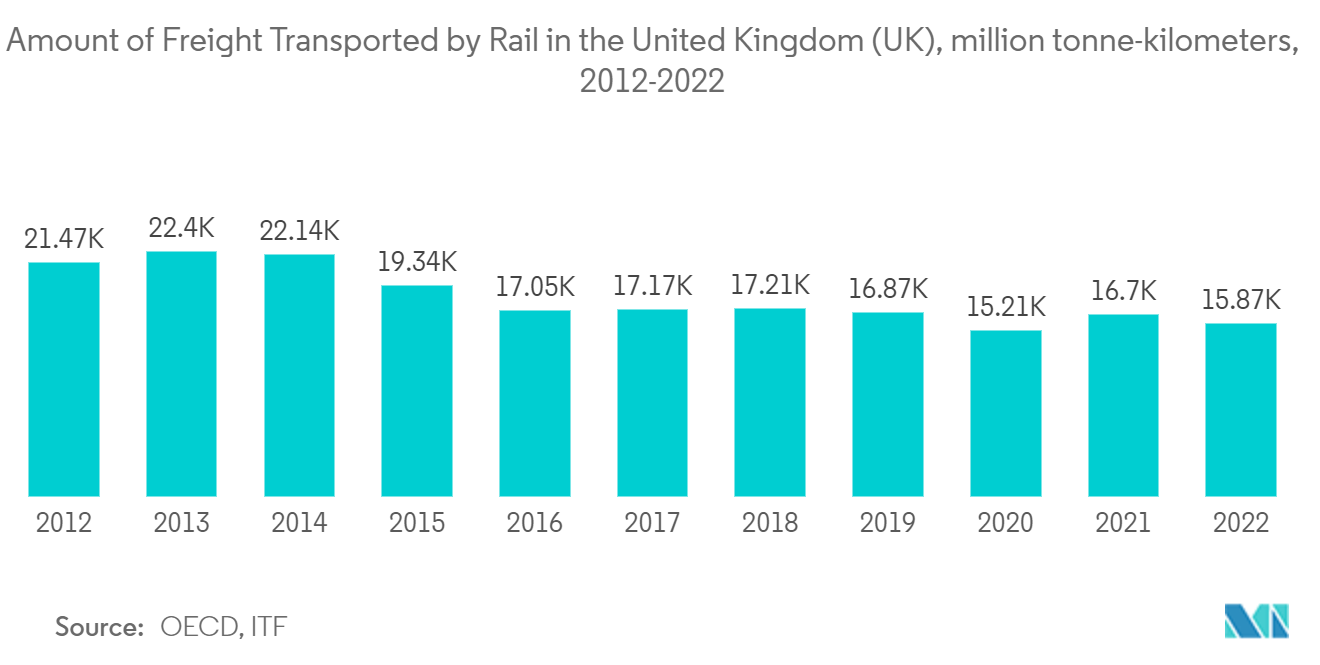
Asia Pacific Will be the Fastest Growing Region During the Forecast Period
Asia-Pacific is emerging as the fastest-growing region in the freight wagon market due to several key factors driving the expansion of rail freight transport and the demand for freight wagons in the region.
Rapid industrialization and urbanization across Asia Pacific countries like China, Japan, and India have led to increased demand for goods and commodities transportation. As economies in the region continue to grow, there is a growing need for efficient and cost-effective logistics solutions to support industries such as manufacturing, construction, and agriculture. With its ability to handle large volumes of freight over long distances, rail transport is becoming increasingly important in meeting this demand.
Additionally, initiatives such as China's Belt and Road Initiative (BRI) aim to improve connectivity and trade between Asia, Europe, and Africa through investments in transportation infrastructure, including railways. The BRI has led to significant investments in rail infrastructure and rolling stock across Asia Pacific countries, driving the demand for freight wagons in the region. For example, China Railway Corporation, the state-owned railway operator in China, has been expanding its fleet of freight wagons to accommodate the growing freight volumes associated with the BRI projects.
Furthermore, environmental concerns and sustainability initiatives are also driving the growth of rail freight transport in Asia-Pacific. As countries in the region struggle with issues such as air pollution and greenhouse gas emissions, there is a growing emphasis on shifting freight transport from road to rail, which is considered a more environmentally friendly mode of transportation. This shift is supported by government policies and regulations promoting rail freight transport and investments in rail infrastructure, contributing to the increasing demand for freight wagons in Asia Pacific.
Overall, with continued investments in rail infrastructure and ongoing industrialization, Asia Pacific is expected to remain the fastest-growing global freight wagon market region during the forecast period.
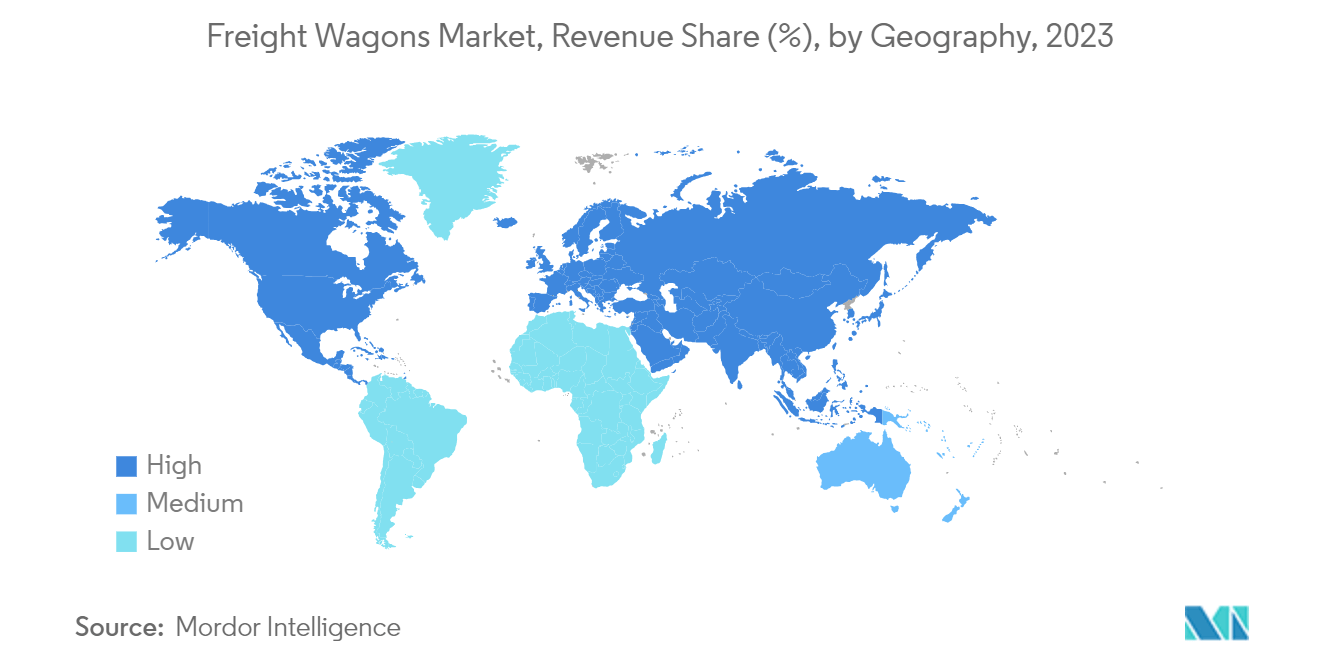
Competitive Landscape
The freight wagon market is fragmented, with several players operating in the market and the top few players holding less than a quarter of the market share. Some of the key players operating in the market are United Wagon Company, FreightCar America, Titagarh Wagons Ltd, AmstedMaxion, and Jupiter Wagons Limited, among others. These are actively gaining a competitive edge by continuously investing in newer and advanced technologies, product partnerships, and collaborations.
Freight Wagons Industry Leaders
-
FreightCar America
-
Titagarh Wagons Ltd.
-
United Wagon Company
-
Jupiter Wagons Limited
-
AmstedMaxion
- *Disclaimer: Major Players sorted in no particular order
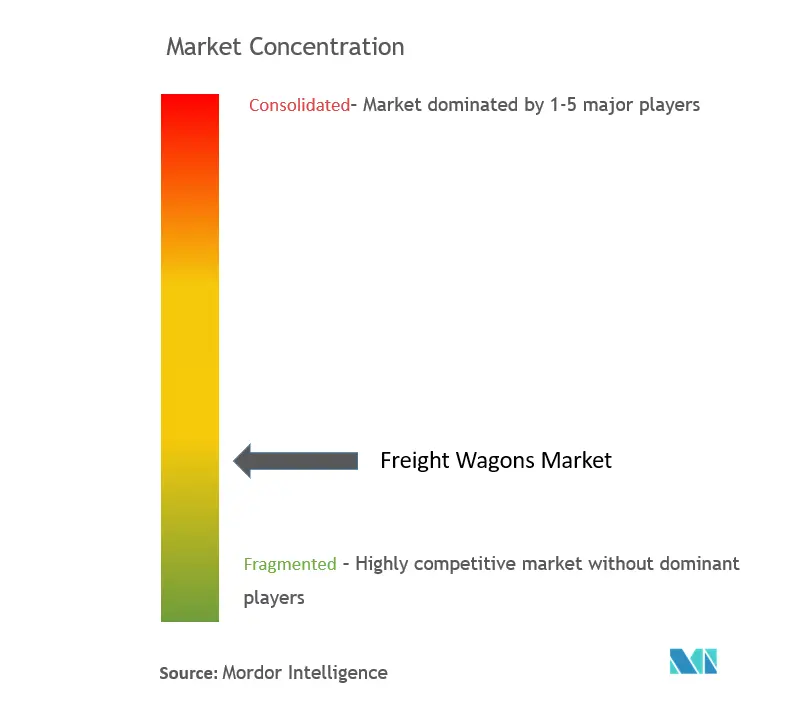
Recent Industry Developments
- December 2023: Jupiter Wagons Limited secured a contract worth INR 1,617 crores (~USD 195 million) from the Ministry of Railways to manufacture and supply 4,000 BOXNS wagons.
- October 2023: The VTG iWagon, the UK’s pioneering digital freight wagon, has been developed through a collaboration between VTG Rail UK and Knorr-Bremse Rail Systems (UK). The iWagon boasts 12 digital innovations that pave the way for future technologies. These innovations, facilitated by the VTG Connect gateway, include axle generators, control over wheelset slides in low adhesion conditions, and the patented Wheel Flat Prevention (WFP) system. Additionally, the iWagon incorporates Brake Condition Monitoring (BCM), eliminating the need for annual brake tests.
Global Freight Wagons Market Report Scope
A freight wagon, also known as a freight car or goods wagon, is a type of railway vehicle designed to transport goods, cargo, or freight over long distances. These wagons typically consist of a robust, flatbed, or enclosed structure mounted on wheels and equipped with couplings to connect to locomotives or other wagons.
The freight wagon market is segmented by wagon type, payload capacity, axle, and geography. The market is segmented by wagon type, such as closed wagon, open wagon, hopper wagon, flat wagon, tank wagon, car wagon, refrigerated wagon, and special purpose wagon. The market is segmented by payload capacity, which is up to 60 tons and above 60 tons. The market is segmented by axle as 2-axle, 2x2 axle, 4-axle, and 6-axle. By geography, the market is segmented as North America, Europe, Asia Pacific, and the rest of the world). The report offers market size and forecasts for all the above segments in value (USD).
| Closed Wagon |
| Open Wagon |
| Hopper Wagon |
| Flat Wagon |
| Tank Wagon |
| Car Wagon |
| Refrigerated Wagon |
| Special Purpose Wagon |
| Up To 60 Tons |
| Above 60 Tons |
| 2-Axle |
| 2x2 Axle |
| 4 Axle |
| 6 Axle |
| North America | United States |
| Canada | |
| Rest of North America | |
| Europe | Germany |
| United Kingdom | |
| France | |
| Rest of Europe | |
| Asia-Pacific | India |
| China | |
| Japan | |
| South Korea | |
| Rest of Asia-Pacific | |
| Rest of the World | South America |
| South Africa | |
| Rest of the World |
| Wagon Type | Closed Wagon | |
| Open Wagon | ||
| Hopper Wagon | ||
| Flat Wagon | ||
| Tank Wagon | ||
| Car Wagon | ||
| Refrigerated Wagon | ||
| Special Purpose Wagon | ||
| Payload Capacity | Up To 60 Tons | |
| Above 60 Tons | ||
| Axle | 2-Axle | |
| 2x2 Axle | ||
| 4 Axle | ||
| 6 Axle | ||
| Geography | North America | United States |
| Canada | ||
| Rest of North America | ||
| Europe | Germany | |
| United Kingdom | ||
| France | ||
| Rest of Europe | ||
| Asia-Pacific | India | |
| China | ||
| Japan | ||
| South Korea | ||
| Rest of Asia-Pacific | ||
| Rest of the World | South America | |
| South Africa | ||
| Rest of the World | ||
Key Questions Answered in the Report
How big is the Freight Wagons Market?
The Freight Wagons Market size is expected to reach USD 15.24 billion in 2025 and grow at a CAGR of greater than 4% to reach USD 18.54 billion by 2030.
What is the current Freight Wagons Market size?
In 2025, the Freight Wagons Market size is expected to reach USD 15.24 billion.
Who are the key players in Freight Wagons Market?
FreightCar America, Titagarh Wagons Ltd., United Wagon Company, Jupiter Wagons Limited and AmstedMaxion are the major companies operating in the Freight Wagons Market.
Which is the fastest growing region in Freight Wagons Market?
Asia Pacific is estimated to grow at the highest CAGR over the forecast period (2025-2030).
Which region has the biggest share in Freight Wagons Market?
In 2025, the North America accounts for the largest market share in Freight Wagons Market.
What years does this Freight Wagons Market cover, and what was the market size in 2024?
In 2024, the Freight Wagons Market size was estimated at USD 14.63 billion. The report covers the Freight Wagons Market historical market size for years: 2019, 2020, 2021, 2022, 2023 and 2024. The report also forecasts the Freight Wagons Market size for years: 2025, 2026, 2027, 2028, 2029 and 2030.
Page last updated on:
Freight Wagons Market Report
Statistics for the 2025 Freight Wagons market share, size and revenue growth rate, created by Mordor Intelligence™ Industry Reports. Freight Wagons analysis includes a market forecast outlook for 2025 to 2030 and historical overview. Get a sample of this industry analysis as a free report PDF download.
